Free Shipping on orders of $49+ | Signup for Direct Rewards
Free Shipping on orders of $49+ | Free Store Pickup | Signup for Direct Rewards
Free Shipping on orders of $49+ | Signup for Direct Rewards
Free Shipping on orders of $49+ | Free Store Pickup | Signup for Direct Rewards

Happy National Wildlife Day! Here at Divers Direct we’re celebrating by writing about one of our beloved sea creatures, Turtles! Did you know there are over 350 species of turtles around the world? These ancient reptiles can be found in the sea, in freshwater, or on land. Ancient remains of turtles can be dated all the way back to over 220 million years ago. That means turtles are even older than crocodiles and snakes. Turtles truly are a dinosaur!
Turtles are what you would call amniotes. This means that they breathe air and lay eggs on land. But although they lay eggs on land, almost all species of turtles reside in or near water. Majority of the world’s turtle species live in North America and South Asia. We currently have over 30 species that call Florida home today. Most of these species though, such as sea turtles, are primarily aquatic. Dive in deeper to learn more about amazing sea turtles.
Before getting into the different species of turtles, it is important to note that all tortoises are turtles, but not all turtles are tortoises. Tortoises have much rounder, domed shells, while turtles have flatter, streamlined shells to help them glide through the water at surprisingly fast speeds. There are 7 species of sea turtles; Loggerhead, green, leatherback, hawksbill, kemp’s ridley, flatback, and olive ridley. It is basically impossible to estimate exactly how many sea turtles there are in the world. These sea turtles visit specific beaches to lay their eggs and then head back out into the open ocean. Some turtles will even dive down to over 3,000 ft deep!
Turtles can come in many different shapes and sizes. The Speckled Cape Tortoise is the smallest turtle that grows to 3.1 inches and weighs only 5 ounces. While the leatherback sea turtle is the largest sea turtle growing to over 5 feet and weighing up to 1,500 lbs! Diving with these turtles can be quite wondrous! They move slowly and calmly in the ocean allowing for some excellent photo-ops. However, it is important to always approach turtles from the side, and to never swim above a turtle. When swimming up to a turtle, do so slowly and calmly. Avoid touching the turtle or making any sudden movements. If the turtle begins to swim towards you, just remain still, or slowly move out of its way.
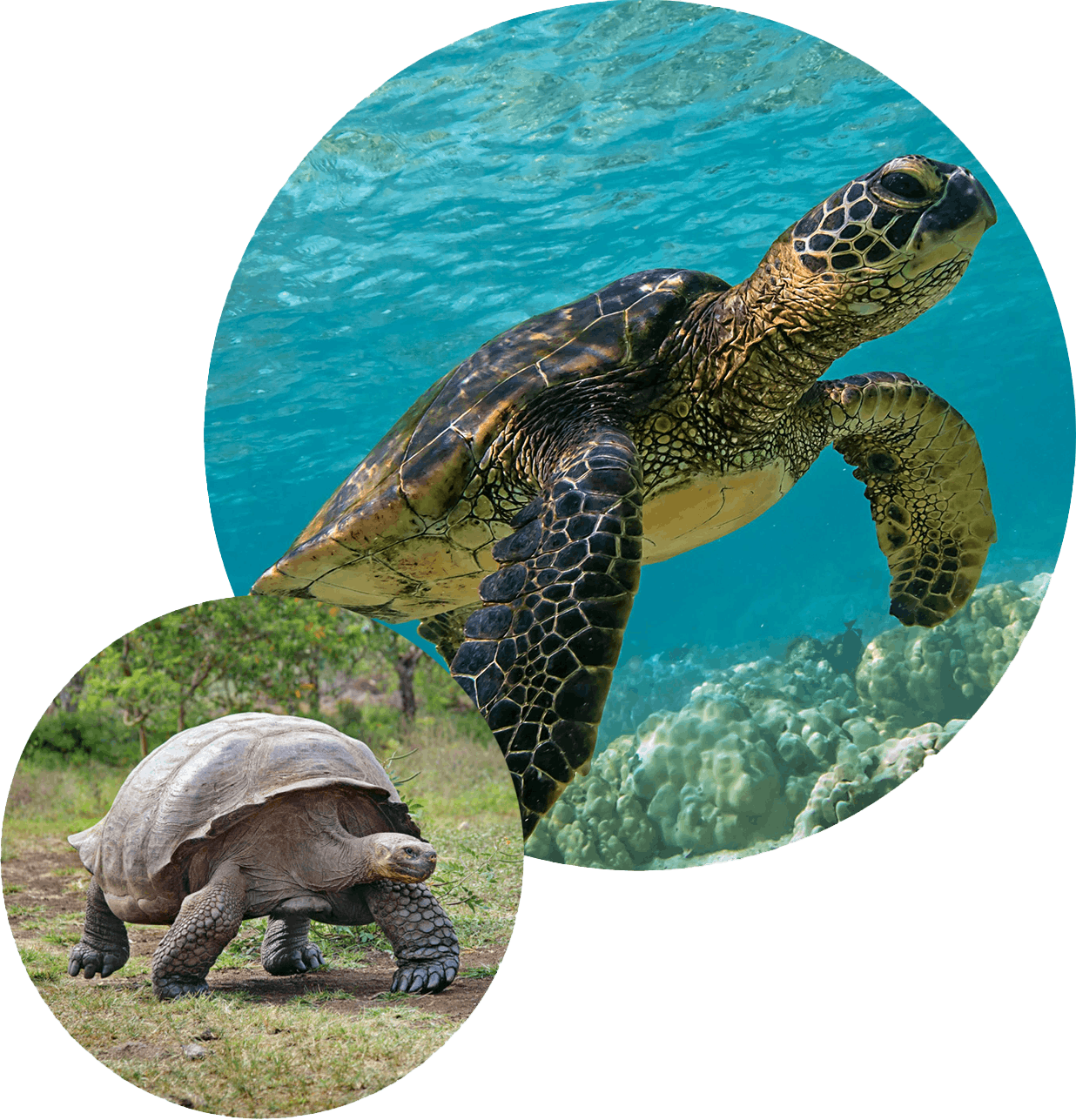
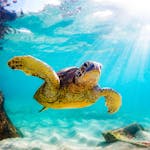
Florida is home to a total of 32 different turtle species; 26 freshwater turtles, 5 sea turtles, and 1 tortoise. Florida actually only has one native species of tortoise, the Gopher Tortoise. There is a wide variation of freshwater turtles in Florida. From Box Turtles, to Cooters, to Snappers and Soft Shell Turtles, there are almost too many to count. We will be focusing on the 5 sea turtles that you can see diving in our beautiful oceans.
If you would like to learn more about freshwater species in Florida, click here.
Like we mentioned above, there are 5 species of sea turtles that you can find in Florida’s waters. Loggerheads, Green Turtles, Leatherbacks, Kemp’s Ridleys, and Hawksbills all call Florida their beautiful home.
Loggerhead - Loggerhead Sea Turtles are the most common sea turtle in Florida. Named after their enormous “log” like head, Loggerheads are some of the largest sea turtles. Growing to an average of 3ft long and weighing an average of 275 lbs, diving with these giants can be quite the experience. Loggerheads have extremely powerful jaws that allow them to crush clams, crabs, and other armored animals with ease. Loggerheads are a slow moving sea turtle compared to the green turtle, but they make up for their lack of speed with high stamina. Some Loggerheads will travel thousands of miles across the globe to reach the prime nesting sites in Florida.
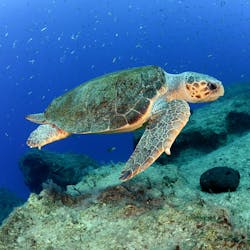
Green Turtle - As one of the world's largest turtle species, Green Turtles grow up to 4ft long and weigh an average of 350 lbs! Named after the layer of green fat under their shell, Green Sea Turtles are primarily vegetarian. Juveniles will eat small crustaceans and worms, but once adults, they primarily feed on algae and sea grass. Green Turtles are among the faster species of turtle reaching speeds of up to 21 mph but typically cruising around 2 mph. Divers can see Green Turtles pretty often since they typically reside in shallower waters on coral reefs. When diving at the same spots, it can be common to see the same turtles at the same time every year. This is because Green Sea Turtles will migrate thousands of miles to breed along the same beaches they were born.
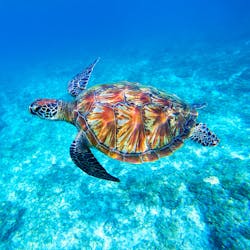
Leatherback - As the largest turtle species on the entire planet, Leatherbacks can grow up to 8ft long and weigh over 1500 lbs! Leatherbacks prefer deeper, colder waters than any other sea turtle. But they will nest almost exclusively right here on Florida’s east coast! Diving with a Leatherback is typically more rare. They are normally found in the open ocean, but can be found near feeding areas. Leatherback's diet consists of mostly jellyfish, but they can also eat planktonic tunicates and some fish. Being so large, their speed is incredible. Leatherbacks can reach speeds of 20 mph to escape predators!
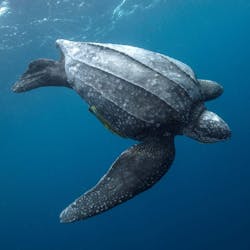
Kemp’s Ridley - Found mostly in the Gulf of Mexico, Kemp’s Ridley Sea turtles are the most endangered species of sea turtle in the world. They are the smallest of sea turtles. Growing to an average size of 2ft long and typically weighing less than 100 lbs. When it comes to food, Kemp’s Ridleys love their crabs! Their diet consists of primarily Blue Crabs, but they can also feed on shrimp, clams, and mussels. Kemp’s Ridley sea turtles can stay underwater for over 4 hours and even sleep underwater before returning to the surface for air. Make sure not to disturb them if you find one taking a nap.
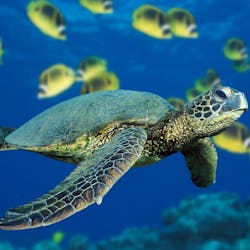
Hawksbill - Hawksbill sea turtles are most distinguishable by their beak shaped mouths. They use their unique jaws to feast on sponges. Sponges are composed of tiny glasslike needles, but this causes the turtle no harm. Hawksbill sea turtles will also feed on squid, shrimp, jellyfish, marine algae, and more. The Hawksbill is one of the smaller sea turtles growing up to only 45in long and weighing between 100 and 150 lbs. You can find these turtles in the open ocean, or in rocky areas and coral reefs.
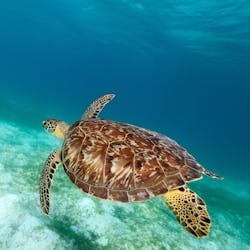
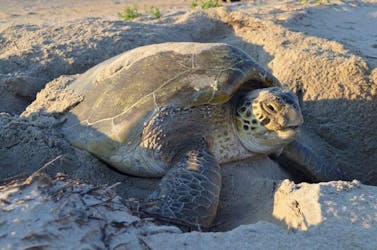
Green Sea Turtle burying her nest
All turtles lay their eggs on land, and then pretty much leave them to fend for themselves. A young turtle's journey from the beach to the open ocean is one of the most dangerous portions of their life. Turtles can take many years to sexually mature depending on their size. Smaller turtles typically reach sexual maturity sooner, but some larger species can take up to 50 years to lay their first clutch of eggs. Sea turtles can travel thousands of miles to lay their eggs on the same beaches they were born on. All female sea turtles must lay their eggs on land which exposes them and their young to predation from a wide variety of predators including humans!
The amount of eggs a turtle will lay varies between species. Smaller species will of course lay fewer eggs. Some as low as one or two. Leatherback sea turtles produce on average 50-90 eggs per clutch, while Hawksbill sea turtles, even though smaller, can lay 140-160 eggs per clutch. Most species lay their clutch once per year, some every other year, and some will lay 4 times in one nesting season! Sea turtles typically will only nest every few years, but will lay multiple clutches each season. This is perhaps an evolutionary trait since the majority of their juveniles don’t make it to maturity.
When sea turtles nest they will typically return to the same beaches they were born to lay their eggs. Some species like Leatherbacks will travel thousands of miles to return to these beaches which is quite remarkable! Once they beach themselves, they will use their hind limbs to scoop sand out of the way digging down as deep as their flipper can go. The female turtle will drop her eggs into the nest, and then cover them with the sand she just removed.
Where these eggs are laid and the temperature of the environment play a big part in how long it will take until they are ready to hatch. Warmer temperatures will cause fast development, while cooler temperatures slow development. Typically, incubation can range from 45 to 75 days. The sex of the turtles are also determined by temperature. Above 82° will cause the hatchlings to be primarily female, while below 82° will result in more males. With recent temperatures increasing due to global warming, there have been far less male hatchlings. This is detrimental to the population of sea turtles.
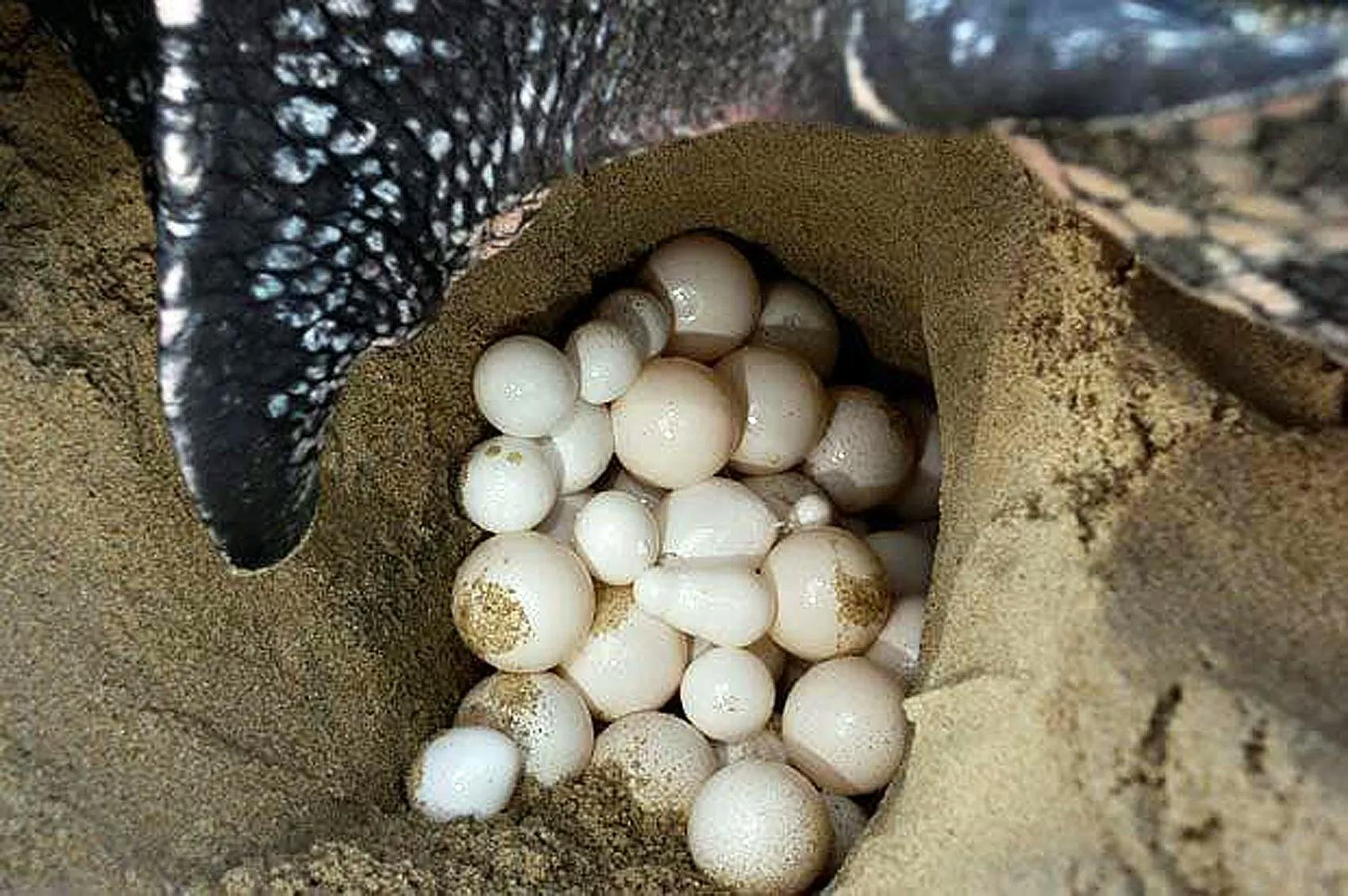
Like a bird's egg tooth, sea turtle hatchlings have a small pointy bump on the tip of their nose. They use this to push against the eggshell and break it. Once out of their shell, the hatchlings will begin to dig towards the surface. When they reach the surface, this is the most dangerous point of their life. It’s estimated that only 1 in every 1,000 sea turtles will become an adult. They can be scooped up by birds, ravaged by racoons, or gulped down by large fish.
Turtles Longevity

Jonathan (left) circa 1882
The claim that turtles can live over 100 years old is true! In captivity, some tortoise species can even live up to 250 years old. The oldest tortoise, “Johnathan” is the world’s oldest known terrestrial animal at around 190 years old. There have actually been recorded cases of turtles that have mysteriously changed their sex from when they were born. This can make it difficult to properly date some older turtles.
When it comes to sea turtles, they will typically live at least 60 years. This is partly due to the fact that they don’t mature until they are around 40 years old. They can live decades after maturity, producing young every few years.
Turtles are in danger from the moment they hatch to their adulthood. As hatchlings, many predators will hunt them on the journey from the beach to the open ocean. However, once adults, their life gets a little easier with only sharks and crocodiles as their main predators. Not including humans of course!
Turtles can be captured in commercial fishing nets accidentally. This is called bycatch and is devastating to sea turtle populations. Sea turtles are essential to aquatic ecosystems, helping to maintain the health and population of sea grass fields and coral reefs. These ecosystems house many small organisms that will indefinitely feed small fish, feeding larger fish, and then other organisms all the way throughout the food web. Turtles also have a major cultural significance and tourism value that helps keep countries surviving in areas where tourism is the primary source of income.
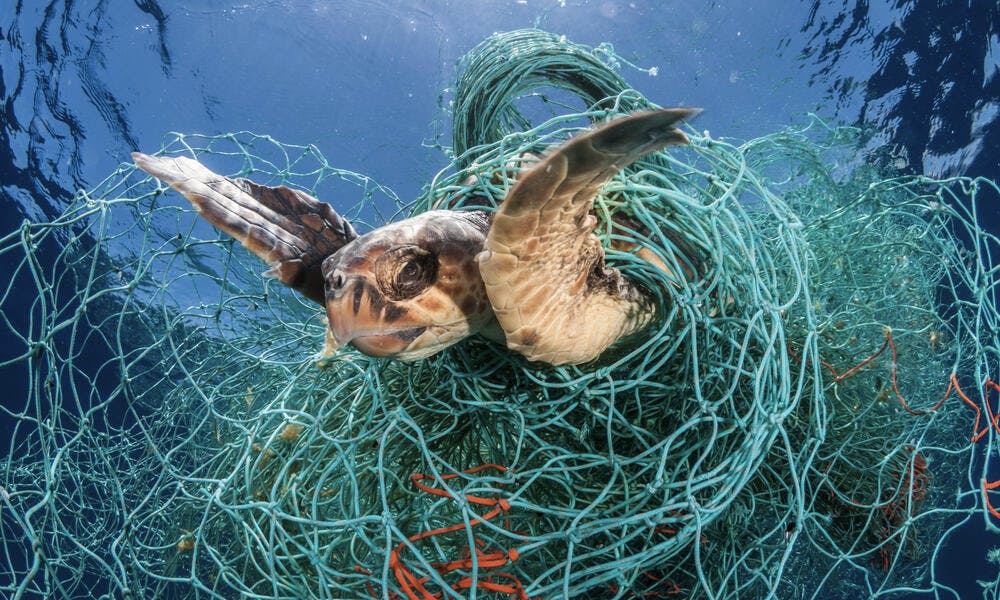
Some threats to sea turtles include:
More than half of the world’s turtles are recognized as endangered or threatened. 187 species currently meet the criteria, and we’re not exactly headed in the right direction. Turtles have been on earth for more than 220 million years, so let’s not put an end to their streak.
There are a number of things you can do to help sea turtles in and out of the water. From picking up trash along the beach, to avoiding jewelry made from sea turtle shells, there are a wide variety of ways for everyone to help.
Some ways to help are;
There are many places around the world to dive with sea turtles. Florida is an excellent place to snorkel or scuba dive with turtles because 5 of the 7 species migrate to Florida to breed every year. Sea turtles are typically very calm and gentle. They may even swim up to divers in areas where they have become accustomed to them. Sea turtles are known to be very timid though. You must be sure to move slowly and calmly so as not to spook the turtle. Always approach turtles from the side so that you are in their full view. There is no minimum distance you should be from a turtle, but you should try to remain 10 feet away from them unless they are approaching you. Never swim above a turtle. They will need to come to the surface for air, and you don’t want to prohibit them from doing so. Never touch or feed a turtle. It can be dangerous for the turtle or even you, and in many areas it is illegal to do so.
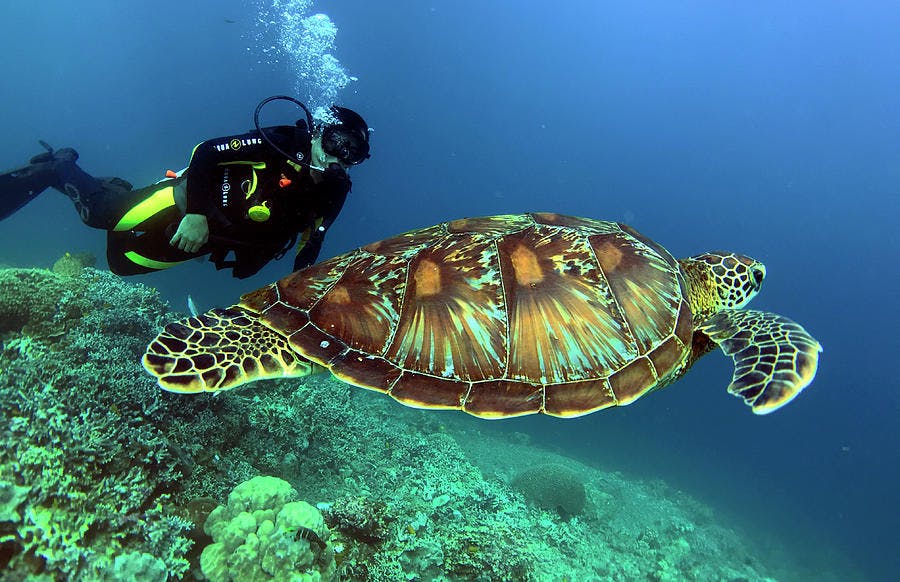
With increasing threats to our beloved sea turtles, it is important that we all know and understand how essential turtles are to the oceanic ecosystem. Almost all sea turtle species are endangered, so dive responsibly and make sure to put in effort on land and on the water to help support these beautiful creatures.
Written by: Steven Fandl
Turtles can live anywhere from 10 to 250 years depending on the species. Most sea turtles will live for at least 60 years. The oldest tortoise, “Johnathan” is the world’s oldest known terrestrial animal at around 190 years old.
Turtles are reptiles! They breathe only through their lungs and have dry, scaly skin to keep moisture in even when sunbathing.
There are many beaches around the world to observe nesting turtles and hatchlings. In Florida, it is best to go anywhere on the east coast between Titusville and Fort Lauderdale. It is best to go at night, but make sure to avoid using any lights, and not to get into the way of the turtles.
Yes! Six of the seven species are listed and protected under the Endangered Species Act. Three of the seven species are listed as critically endangered.
Dinosaurs and turtles are both reptiles, and are related to each other. They do share some common ancestors, but turtles split off from dinosaurs early on.
Turtles can eat a wide variety of small organisms from shrimp and jellyfish to crabs and clams. Some species of turtle will eat these small organisms as juveniles but will transition to herbivores as they mature.
No. A turtle’s shell is actually part of their skeleton. Their skeletons are made up of 50 bones including the spine and rib cage. As a turtle grows, its shell grows with them. Just like how our bones grow!